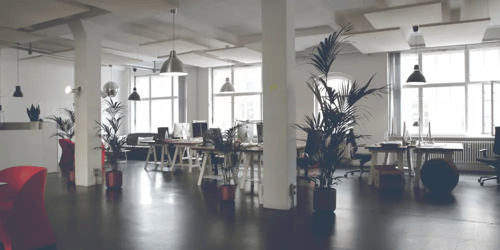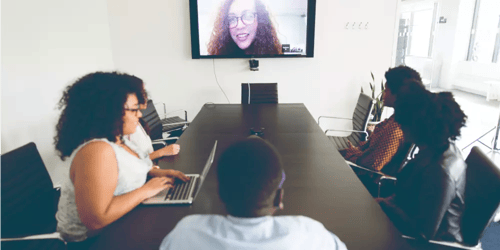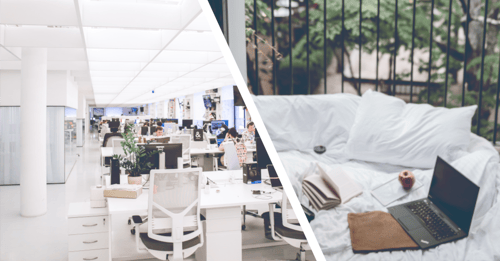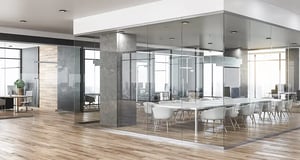When you envision a modern workplace what comes to mind? Game rooms? Nap pods? A fully-stocked kitchen with beer on tap? Or do you envision a co-working space with many different types of people and businesses working in a common area? Perhaps you thought of cubicles? Or did you instead envision an open-concept space with walled-off meeting rooms?
Regardless of our personal vision, there are some clear workplace design trends that define the modern workplace. A tech-ready space with high-speed internet and accessible smartphones is a must. Technology and tools to make work more efficient is just the beginning, as a modern workspace should also embody the company's culture and values, making it an attractive and supportive environment for employees to thrive in, leading to increased productivity.This will also lead to attracting and retaining employees within an organization. It reflects the modern approach of physical workspaces.
What is the definition of a modern workplace?
A modern workplace is characterized by a combination of technological, physical, and psychological factors aimed at balancing employee satisfaction and business efficiency. The definition of a modern workplace is constantly evolving to meet the changing needs of both employees and businesses.

What does a modern workplace design look like?
Contemporary workspaces are likely to be designed around a concept known as activity-based working. This approach involves incorporating open spaces with designated areas for specific activities, which is a departure from the traditional office model where quiet workstations are enclosed and noise-prone spaces are open.In other words, these open workstations might be turned to quiet spaces just like in a library with the enclosed spaces becoming conversation or privacy-based spaces.
Activity-based workspaces are flexible and adaptive to employees' changing needs throughout the day. They allow employees to choose the space that best suits the tasks they need to perform and cater to diverse working styles. This means that employees may not have a fixed desk, but instead use hot desks, sound-proofed booths for phone calls, pre-booked meeting spaces with tech-equipped facilities, huddle rooms for small group collaborations, and other tools to maximize their productivity.
This type of collaborative workspace provides choice for employees; they decide how, when, and where to work, allowing them to be more effective and engaged throughout the day. It is flexible enough to let employees be fully productive. In order to find a modern workplace design example for your office, here are modern workplace examples from AskCody clients and partners.
An activity-based workspace also accommodates today’s trend of on-demand culture, where there are changing needs to be met throughout the day. It allows more flexibility in the workspace, allowing it to meet the needs of different groups simultaneously.
The key to making it all work is to build the organizational culture around it—showing employees that their needs and ability to be productive are not afterthoughts.

The role of technology and collaborative components in the modern workplace
The modern workplace is designed with a focus on technology, productivity, and collaboration. Essential components of a contemporary workspace include meeting rooms equipped for video conferencing, high-speed internet access for all employees, and options for working outside of traditional business hours. These design elements aim to optimize office space and meet the changing needs of today's workforce.
Effective communication and collaboration are crucial in attracting and retaining the best employees. In fact, 99% of workers prefer a workplace where communication is prioritized, and companies that invest in tools and processes to improve communication are 4.5 times more likely to retain top talent. The digital age has blurred the lines between work and personal life, and employees are expected to keep pace with fast-moving communication.
Another workplace trend that is perfectly clear: Today’s life is more digital thanks to technology. We’re able to be online and available if we choose 24/7. We have blurred lines between work life and home life. Technology facilitates collaboration and seamless communication easier than ever. With numerous collaboration tools available, it can be challenging to choose the right one for a company's specific needs. Microsoft 365 and the Microsoft modern workplace are just one example of a suite of productivity-enhancing tools. Other options include:
- SharePoint Online, which is a cloud-based storage and collaboration tool that helps organizations share and manage content and files with secure file sharing, document collaboration, metadata management, and advanced search features.
- Outlook Groups, which is a feature within Microsoft 365 that allows you to create a group chat and collaboration space based on a discussion in email, SharePoint, Team, Planner, and others.
- Yammer Groups, which integrates with Outlook and OneDrive and creates a feed where users can see the most popular posts, follow posts, and even leave comments. It was designed to foster open communication within large groups, and it works well in a changing workforce where many younger workers are familiar with social media.
- Microsoft Teams, which is used for chat-based teamwork. It is similar to the popular online collaboration tool Slack with channels, commenting, and one-on-one messaging features.
- To Do, which helps users track tasks, share lists, and break tasks down into manageable parts.
- One Drive, which is Microsoft’s cloud storage service with real-time co-authoring, share at will, offline access, and syncing across devices.
- OneNote, which is a program designed to gather, organize, and share free-form information in a collaboration space.
- Shifts, which is a Microsoft mobile app designed to help teams manage tasks and shifts across organizations or teams, view their schedule, and do other tasks like request time off.
- Flow, which automates and streamlines workflows to increase productivity.
- Skype for Business, which makes audio, video, and conference calls. In addition, users can set a status, send and receive text messages, personalize their contact card, and host meetings.
- AskCody, which makes collaboration easier by streamlining labor-intensive tasks related to booking meetings through Outlook and Microsoft Office 365. Features include hot desk booking, meeting room booking, the ability to order catering, reduce double bookings, and even manage visitors.
Before implementing a particular tool or process, companies should first analyze the functionality that comes with it and decide if it will help their teams work together better. Test the new tool with a small group and evaluate the benefits before rolling out a tool to the entire team.
Finally, do not underestimate the power of training. While many tools may seem intuitive, training can ensure your team is able to leverage the full power of these collaboration tools.

The influence of COVID-19 on the modern workplace
In early 2021, 4.7 million workers in the United States telecommuted, highlighting the need for real-time collaboration and communication with team members around the world, both for remote and in-office workers. However, this shift towards remote work has also revealed some challenges, such as the difficulty of conducting generative collaboration in an all-virtual environment.
"Informative and evaluative collaboration can easily happen via video. But generative collaboration is the most challenging in any condition and the most difficult to replicate online. In an all-virtual environment people struggle to have a normal flow of conversation and read body language” Source: Steelcase.com
Besides making collaboration tougher, people also simply miss working together.We are social beings. COVID-19 taught us that more work can be done from home than we realized before, but it also highlighted how lonely it can be and what we are missing when we do not see our colleagues. This has led to a search for a balance between flexibility and in-person interactions, to overcome the downsides of a fully-remote workforce, such as reduced employee development, innovation, and leadership growth.
The COVID-19 pandemic showed us how well remote work can be done, but it also highlighted the importance of our in-person bonds and the difficulties of building relationships, leading, and innovating remotely. In order to encourage employees to return to a shared, in-person environment, the modern workplace must be designed for collaboration, offering clear benefits over working from home. People want to be social, but not at the expense of getting things done.
In conclusion, COVID-19 has given us a glimpse into the possibilities of remote work, but it has also shown us the limitations and the need for a more hybrid model in the future workplace. To plan for the future, we must consider the benefits and challenges of remote work and the importance of designing the modern workplace for collaboration.

The modern workplace culture and multi-generational needs
The design of a flexible work arrangement is centered around a transformation in organizational culture that prioritizes trust in employees. To function at optimal levels, employers and individual leaders within the organization need to give employees the power to make decisions that benefit their workday. Micromanaging or limiting employee use of the workspace only during specific times will stifle efficiency and limit the potential of both the workspace and the employees.
This shift may require a cultural change, particularly in modern workplaces where multiple generations coexist. The traditional cubicle or office-style work environment where everyone stays in one assigned space except for meetings or breaks is no longer the norm.
The transition to this new organizational culture can be challenging for organizations that have long relied on traditional working spaces and cultures. The process requires collaboration from top to bottom, including support from the IT team to ensure all necessary tools are in place. Leaders must model the desired behaviors, and supervisors must receive training to avoid evaluating employees based on outdated norms.
Flexibility is valued by younger generations, who expect a healthy work-life balance and the possibility of remote work at least part of the time. The gig economy has become a common aspect of modern life, with Gen X, Millennials, and Zoomers all participating in on-demand services for primary or secondary income sources or by using services such as ride sharing and food delivery. Organizations must adapt to these changing cultural expectations, as even if their customers do not require it, their employees likely do. Employees expect flexibility and the ability to be efficient and have on-the-go tools at their disposal in the modern workplace. This is the backdrop for everything we’ve discussed here: Changing generational expectations lead to changing workplace norms in the modern workplace.

7 trends in the modern workplace
Microsoft published outcomes of a survey they did on ways of working, it revealed 7 trends and confirmed Hybrid as the way forward at modern workplaces. We will take a look at those trends;
- Working flexible is not going anywhere
- There is a disconnect between Leaders and employees which need attention
- Seemingly high productivity is hiding a workforce at its limits
- Zoomers need an energy boost
- Shrinking networks are endangering innovation
- Authenticity will amplifies productivity and wellbeing
- Globalization of Talent in flexible and hybrid work environments
Read more about these trends and Hybrid work in Microsoft Work Trend Index
4 best practices for modernizing your workplace
Now that we understand the cultural and technical realities of the modern workplace, here we highlight four tactics companies can implement to bring out the best in their employees.
1. Stimulate a healthy workplace environment
A healthy work environment, where employees feel valued and appreciated, can increase job satisfaction and reduce turnover. Modern companies understand the importance of investing in learning, training, and development programs to boost employee motivation, performance, and overall productivity.
Working efficiently with Millennials and Zoomers requires avoiding the assumption that seniority necessarily equates to competence, as this can be a demotivating factor for them. Companies should focus on actual performance as the basis for promotions and provide equal opportunities for growth and advancement.
Work-life balance is a critical aspect of the modern workplace. By offering flexible work arrangements and accommodating employees' personal needs, companies can foster a happier and more productive workforce. Making it easy to take time for unexpected doctors’ appointments, childcare needs, and family time will help employees feel happier, healthier, and significantly more productive.
2. Communicate and collaborate
The modern office prioritizes setting aside time for team meetings—either virtual or in person—to build relationships, conduct organized brainstorming and results reporting, and encourage collaboration.
Planned meetings also have a two-fold benefit for different kinds of workers. They break independent workers out of their “headphone zones” and signal to those who might regularly “pop in” to others’ offices that there is a more appropriate time and place for collaboration.
Avoid wasting the four hours that the average office worker spends prepping for meetings each week with meeting management software that enables users to quickly find meeting rooms and other spaces, book them directly from a smart device or digital display right outside the meeting space, handle guest registration, and even secure resources and catering!
3. Design your modern work environment to match the needed activities.
A recent survey by PwC revealed that collaboration, client/colleague meetings, and training and career development are the top reasons for employees to return to the office post-COVID-19. When designing your agile work setting, consider what your employees need to perform their best. For example, professional meeting rooms, huddle spaces, café-style areas, or a comfortable indoor environment may be necessary to improve collaboration and employee efficiency.
Consider what this means for the design of your modern work environment, would you need more representable, professional looking meeting rooms? Can you stimulate collaboration by having huddle rooms? Maybe it is time to convert your coffee corner to a more café-style area? Or do you need a better indoor environment to improve employee efficiency?
4. Optimize your tech stack to spur hybrid work
Cloud or SAAS based technology offers you a scalable, accessible, and efficient solution for hybrid work, allowing employees to collaborate seamlessly regardless of location. By optimizing your tech stack, companies can improve the employee experience and support a flexible, hybrid work environment.
Now that you have a better grasp on how the workplace has changed substantially when it comes to technology and culture—go out there and create a competitive, modern workplace.
And while you are at it, download our free ebook to learn how to do so with more efficient meetings, better resource usage, and overall better business productivity.




